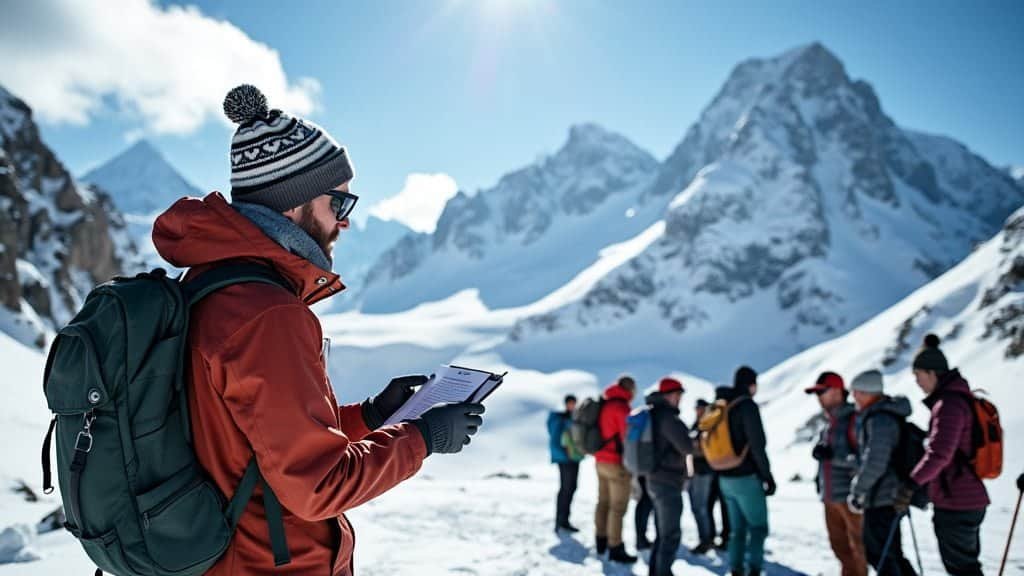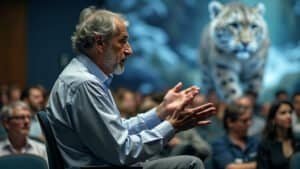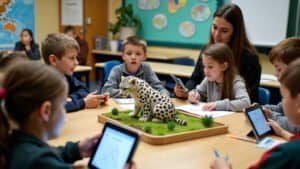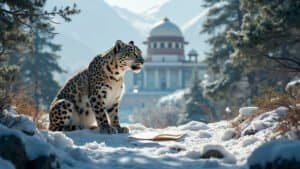Introduction
Science communicators play a pivotal role in snow leopard conservation by raising public awareness, engaging communities, and working alongside conservation organizations to protect this endangered species
This article explores the various ways in which science communicators contribute to snow leopard conservation efforts. From effective awareness campaigns to the impact of media coverage, we will delve into the strategies, collaborations, and challenges faced by science communicators as they work to ensure the survival of these majestic cats
Raising Awareness About Snow Leopard Conservation
Science communicators are essential in bringing attention to snow leopard conservation. They serve as a bridge between the scientific community and the public, making complex research and conservation efforts accessible and engaging
By raising awareness, they help create a broader understanding of the threats facing snow leopards and the importance of preserving their habitats. This awareness is crucial for garnering public support, influencing policy decisions, and driving conservation funding
Importance of Public Awareness
Public awareness is the foundation of successful conservation efforts. Without widespread understanding and concern for the plight of snow leopards, it becomes challenging to mobilize the necessary resources and support
Science communicators help the public comprehend why snow leopard conservation is critical, highlighting not just the species’ intrinsic value but also their role in the broader ecosystem
They explain how the survival of snow leopards is tied to the health of mountain ecosystems, which provide essential resources like water to millions of people downstream. This connection between species conservation and human well-being is a powerful message that can motivate people to support conservation efforts
Methods of Effective Science Communication
Science communicators employ various methods to raise awareness about snow leopard conservation. Storytelling is one of the most effective techniques, as it humanizes scientific data and makes the information relatable. By sharing stories of individual snow leopards or the experiences of researchers in the field, communicators can evoke emotional responses that inspire action
Visual media, such as photography and videography, also play a crucial role in capturing the public’s attention. Stunning images of snow leopards in their natural habitat or videos showcasing the challenges they face can quickly go viral, reaching a global audience
Another vital method is the use of clear, jargon-free language. Many people are intimidated by scientific terms, so communicators must present information in a way that is easy to understand. This approach not only makes the content more accessible but also ensures that the message is retained and shared among broader audiences
Additionally, science communicators often work with journalists and media outlets to disseminate information widely, ensuring that stories about snow leopards reach as many people as possible
Case Studies: Successful Awareness Campaigns
Several awareness campaigns have successfully brought attention to snow leopard conservation. For example, the “Ghost of the Mountain” campaign by the Snow Leopard Trust used powerful imagery and storytelling to highlight the elusive nature of snow leopards and the threats they face. This campaign reached millions of people worldwide, raising significant funds for conservation efforts
Another example is the “Vanishing Treasures” initiative by the United Nations Environment Programme (UNEP), which focuses on the impacts of climate change on mountain species like snow leopards
This campaign effectively combined scientific research with compelling narratives, helping to elevate the issue on the global stage. The use of social media and partnerships with influencers also amplified the message, demonstrating the power of modern communication tools in conservation
These case studies show how science communicators can galvanize public support through well-crafted campaigns. By leveraging different media platforms and engaging storytelling, they have been able to turn complex conservation issues into accessible and emotionally resonant messages that spur action
Engaging the Public in Snow Leopard Conservation
Engaging the public is a crucial aspect of snow leopard conservation, as it turns passive awareness into active participation. Science communicators play a vital role in this process by creating opportunities for people to get involved directly in conservation efforts
This engagement not only builds a sense of ownership and responsibility but also helps to gather crucial data and resources needed for effective conservation
Use of Social Media and Digital Platforms
In the digital age, social media and online platforms have become powerful tools for engaging the public in conservation efforts. Science communicators utilize these platforms to reach a broad audience, sharing updates, educational content, and calls to action
Platforms like Twitter, Instagram, and Facebook allow communicators to create interactive content that encourages public participation. For example, online campaigns that ask users to share snow leopard images or facts can quickly go viral, spreading awareness and encouraging others to join the cause
Crowdsourcing platforms also play a role in public engagement. Through initiatives like crowdfunding, the public can contribute financially to specific conservation projects, giving them a direct stake in the outcomes
This method not only raises funds but also creates a community of supporters who are personally invested in the success of snow leopard conservation efforts
Educational Programs and Workshops
Educational programs and workshops are another effective way science communicators engage the public. These programs can be targeted at various age groups, from schoolchildren to adults, ensuring that conservation messages reach a broad audience
Science communicators often collaborate with schools, universities, and community organizations to develop curricula and workshops that educate participants about snow leopards, their habitats, and the challenges they face
Interactive workshops, where participants can engage in activities like tracking snow leopards using GPS data or simulating conservation strategies, help to deepen understanding and foster a connection with the cause. These hands-on experiences make the issue of snow leopard conservation more tangible and personal, encouraging participants to take action in their communities
Additionally, public lectures and events featuring conservation experts provide opportunities for individuals to learn from professionals in the field
These events often include Q&A sessions, allowing the public to engage directly with scientists and communicators, further deepening their understanding and commitment to snow leopard conservation
Community Involvement and Citizen Science
Community involvement is a key strategy for science communicators seeking to engage the public in snow leopard conservation. By involving local communities in conservation efforts, communicators help to ensure that conservation strategies are culturally relevant and sustainable
In regions where snow leopards are native, involving local communities is particularly important, as these communities are often the first to encounter conservation challenges and can provide valuable insights and support
Citizen science projects are an effective way to involve the public in conservation efforts. These projects allow individuals to contribute to scientific research by collecting data, such as tracking snow leopard sightings or monitoring prey species
Science communicators play a crucial role in designing these projects to be accessible and meaningful to non-experts. By participating in citizen science, the public not only contributes valuable data but also gains a deeper understanding of the challenges facing snow leopards and the importance of conservation efforts
Examples of successful citizen science initiatives include the Snow Leopard Conservancy’s “Snow Leopard Scouts” program, which engages local youth in monitoring and protecting snow leopards. This program not only generates important data but also fosters a new generation of conservationists who are passionate about protecting snow leopards and their habitats
By leveraging digital platforms, educational programs, and community involvement, science communicators are able to transform awareness into action, engaging the public in meaningful ways that support snow leopard conservation
Collaboration Between Science Communicators and Conservation Organizations
Collaboration between science communicators and conservation organizations is essential for the success of snow leopard conservation efforts
These partnerships combine the expertise of scientists with the outreach skills of communicators, ensuring that accurate information reaches the public and that conservation messages are effectively conveyed. Through collaboration, science communicators help amplify the work of conservation organizations, making their efforts more visible and impactful
Role of Partnerships in Conservation
Partnerships between science communicators and conservation organizations enhance the effectiveness of conservation initiatives by leveraging the strengths of each partner
Conservation organizations typically focus on research, policy advocacy, and on-the-ground conservation work, while science communicators specialize in making these efforts accessible to the public. By working together, they can create a more cohesive and comprehensive approach to conservation
Science communicators help to distill complex scientific findings into messages that are easy to understand, which is crucial for gaining public support. They also play a key role in developing outreach strategies that resonate with different audiences, from policymakers to local communities
These partnerships can also lead to the creation of joint campaigns, educational materials, and media content that raise awareness and inspire action on a larger scale
For example, the Snow Leopard Trust collaborates with various science communicators to produce documentaries, articles, and social media content that highlight the importance of snow leopard conservation
These collaborations have been instrumental in raising global awareness about the threats facing snow leopards and the efforts being made to protect them
Examples of Successful Collaborations
Several successful collaborations between science communicators and conservation organizations have made significant impacts on snow leopard conservation. One notable example is the partnership between the Snow Leopard Trust and the BBC Natural History Unit
This collaboration resulted in the production of the documentary series “Planet Earth II,” which featured stunning footage of snow leopards in the wild. The series reached millions of viewers worldwide, bringing unprecedented attention to the species and the challenges it faces
Another example is the collaboration between Panthera, a global wild cat conservation organization, and National Geographic. Together, they developed the “Into the Okavango” project, which, while focused on a different species, utilized similar communication strategies that could be applied to snow leopard conservation
This project combined scientific research with compelling storytelling, resulting in a film and educational content that engaged audiences around the world and raised awareness about the importance of wildlife conservation
These examples demonstrate how collaborations can create powerful synergies, combining scientific expertise with effective communication to reach and engage a wide audience. By working together, conservation organizations and science communicators can amplify their impact, ensuring that conservation messages are heard and acted upon globally
Challenges and Solutions in Collaboration
While collaboration between science communicators and conservation organizations offers many benefits, it also comes with challenges
One of the primary challenges is ensuring that the scientific accuracy of conservation work is maintained while making it accessible to a general audience. Science communicators must strike a balance between simplifying complex concepts and retaining the nuances of scientific research
Another challenge is coordinating efforts between multiple organizations, especially when they have different goals, methods, or timelines. Effective collaboration requires clear communication, mutual respect, and a shared vision for conservation outcomes. Establishing formal partnerships with clear roles and responsibilities can help overcome these challenges
Funding can also be a barrier to successful collaboration. Conservation organizations and science communicators often rely on limited budgets, and securing funding for joint initiatives can be difficult
However, by pooling resources and leveraging each other’s networks, these collaborations can attract larger grants or sponsorships, making their projects more sustainable
To address these challenges, successful collaborations often involve regular communication, joint planning sessions, and the establishment of shared goals. By fostering a culture of transparency and cooperation, science communicators and conservation organizations can work together more effectively, ensuring that their efforts are aligned and that their conservation messages have the greatest possible impact
Impact of Media Coverage on Snow Leopard Conservation
Media coverage plays a crucial role in shaping public perception and awareness of snow leopard conservation. By bringing stories of these elusive cats into the public eye, media outlets can generate widespread interest, mobilize support, and influence policy decisions
Science communicators often work closely with journalists, filmmakers, and other media professionals to ensure that the coverage is accurate, engaging, and aligned with conservation goals
Influence of News Media on Public Perception
The news media is a powerful tool for shaping public opinion. When news outlets cover snow leopard conservation stories, they help to raise awareness about the challenges these animals face, such as habitat loss, poaching, and climate change
Coverage in prominent news outlets can bring these issues to the forefront of public discourse, encouraging people to support conservation efforts financially or through advocacy
News stories about snow leopards often highlight both the beauty of these animals and the urgency of their conservation needs. By focusing on the threats to their survival, such as the encroachment of human activities into their natural habitats, these stories can evoke empathy and a sense of responsibility among readers and viewers
This, in turn, can lead to increased support for conservation initiatives and greater pressure on policymakers to enact protective measures
For example, when major newspapers or television networks report on snow leopard conservation efforts, there is often a surge in donations to related causes. Similarly, coverage of successful conservation projects can inspire other regions or countries to adopt similar strategies, creating a ripple effect that benefits snow leopards across their range
Role of Documentaries and Films
Documentaries and films have a unique ability to captivate audiences and bring the plight of snow leopards to life. Through stunning visuals and compelling storytelling, these media forms can convey the beauty and fragility of snow leopards’ habitats, as well as the dedication of those working to protect them
Science communicators often collaborate with filmmakers to ensure that these documentaries are both scientifically accurate and emotionally resonant
One of the most impactful snow leopard documentaries is “The Last Sanctuary,” produced by the World Wildlife Fund (WWF) in collaboration with renowned wildlife filmmaker Sandesh Kadur
This film not only showcases the majestic snow leopards in their natural habitat but also delves into the challenges of conserving them in the face of poaching and climate change. By highlighting the efforts of local communities and conservationists, the documentary inspires viewers to take action in support of snow leopard conservation
Another significant documentary is “Planet Earth II,” which features a segment on snow leopards. Narrated by Sir David Attenborough, the series reached millions of viewers worldwide, raising awareness and generating global interest in snow leopard conservation
The success of these documentaries underscores the power of visual storytelling in conservation, demonstrating how media can bring critical conservation issues to the forefront of public consciousness
Media Campaigns: Successes and Failures
Media campaigns are a strategic way to raise awareness and mobilize public support for snow leopard conservation. These campaigns often involve a combination of news stories, social media outreach, and public service announcements designed to educate and engage the public
Science communicators play a crucial role in crafting these campaigns, ensuring that they are informative, compelling, and resonate with the target audience
One successful media campaign is the “Save Our Snow Leopards” initiative, which was launched by the Snow Leopard Trust in partnership with several international media outlets
The campaign used a mix of social media, online articles, and video content to highlight the threats to snow leopards and the importance of conservation. By engaging a global audience, the campaign successfully raised funds and increased awareness, demonstrating the potential of well-coordinated media efforts
However, not all media campaigns achieve their desired impact. Some campaigns may fail to resonate with the public due to a lack of compelling storytelling, inadequate outreach, or competition with other high-profile issues
For instance, campaigns that rely too heavily on fear-based messaging without offering tangible solutions can leave audiences feeling overwhelmed or apathetic, rather than motivated to take action
To ensure the success of media campaigns, science communicators must carefully consider their messaging, audience, and channels of distribution. Successful campaigns often focus on positive, solution-oriented stories that empower individuals to contribute to conservation efforts, whether through donations, advocacy, or changes in behavior
By leveraging the power of media coverage, science communicators can significantly amplify the impact of snow leopard conservation efforts. Through thoughtful storytelling and strategic campaigns, they can engage a broad audience, inspire action, and ultimately contribute to the protection of this iconic species
Overcoming Challenges in Promoting Snow Leopard Conservation
Promoting snow leopard conservation is a complex task that comes with a variety of challenges
From combating misinformation to addressing cultural barriers, science communicators must navigate a range of obstacles to effectively engage the public and foster support for conservation efforts. Understanding and overcoming these challenges is crucial to ensuring the long-term success of conservation initiatives
Addressing Misinformation and Myths
Misinformation and myths about snow leopards and their conservation can hinder efforts to protect these animals. For example, misconceptions about the danger posed by snow leopards to livestock or local communities can lead to negative attitudes and retaliatory killings
Similarly, myths that snow leopard populations are stable or increasing may reduce the urgency of conservation efforts
Science communicators play a vital role in debunking these myths and providing accurate information. By using evidence-based communication strategies, they can correct misunderstandings and present factual data in a way that is accessible to the public
This often involves working closely with local communities to address specific concerns and provide education on the ecological importance of snow leopards
One effective approach is to use storytelling to challenge myths. By sharing real-life stories of peaceful coexistence between snow leopards and local communities, science communicators can counteract negative perceptions and promote a more positive image of these animals
Additionally, providing platforms for local voices to share their experiences can be powerful in changing public attitudes
Dealing with Cultural and Linguistic Barriers
Cultural and linguistic barriers can also pose significant challenges in promoting snow leopard conservation
In many regions where snow leopards are found, local communities may have different cultural values or beliefs that influence their attitudes toward conservation. Additionally, language differences can make it difficult to communicate conservation messages effectively
To overcome these barriers, science communicators must engage with local communities in culturally sensitive ways. This often involves collaborating with local leaders, educators, and conservationists who understand the cultural context and can help tailor messages to resonate with the community
For example, conservation programs that incorporate traditional ecological knowledge or local customs are more likely to be accepted and supported by the community
Language barriers can be addressed by producing educational materials in local languages and dialects. Science communicators may also use visual communication tools, such as infographics or videos, which can transcend language differences and convey important information about snow leopard conservation in a more universally understood format
In Mongolia, for instance, the Snow Leopard Conservation Foundation has worked with local herders to create educational programs that respect and incorporate local traditions
These programs have been successful in promoting conservation while also preserving cultural heritage, demonstrating the importance of cultural sensitivity in conservation efforts
Strategies for Long-term Engagement
Sustaining public interest and engagement in snow leopard conservation over the long term is another major challenge
Initial enthusiasm for conservation initiatives can wane over time, especially if the public perceives that progress is slow or if other issues capture their attention. Science communicators must develop strategies to maintain momentum and ensure continued support for conservation efforts
One effective strategy is to create ongoing, interactive campaigns that keep the public engaged. This can include regular updates on conservation progress, opportunities for public participation, and the celebration of milestones. For example, involving the public in citizen science projects or community events related to snow leopard conservation can foster a sense of ongoing involvement and commitment
Another approach is to build long-term partnerships with schools, universities, and community organizations. By integrating snow leopard conservation into educational curricula and community programs, science communicators can ensure that the next generation remains informed and engaged in conservation efforts
Additionally, leveraging social media platforms for continuous engagement can help maintain public interest. Regular posts, live updates from the field, and interactive content can keep snow leopard conservation in the public eye and encourage ongoing support
These platforms also allow for direct communication with the public, making it easier to address questions, share successes, and build a community of dedicated supporters
Ultimately, the key to overcoming challenges in promoting snow leopard conservation lies in persistence and adaptability. Science communicators must be prepared to evolve their strategies in response to changing circumstances and to continuously seek new ways to engage and educate the public. By doing so, they can help ensure the long-term survival of snow leopards and the ecosystems they inhabit
Conclusion
Science communicators play a vital role in snow leopard conservation by bridging the gap between scientific research and public understanding
They raise awareness about the importance of protecting these endangered cats, engage the public through digital platforms and educational programs, and collaborate with conservation organizations to amplify their efforts
By leveraging media coverage and overcoming challenges such as misinformation and cultural barriers, science communicators ensure that snow leopard conservation remains a global priority. Their work not only informs and educates but also inspires action, helping to secure a future for snow leopards in the wild







